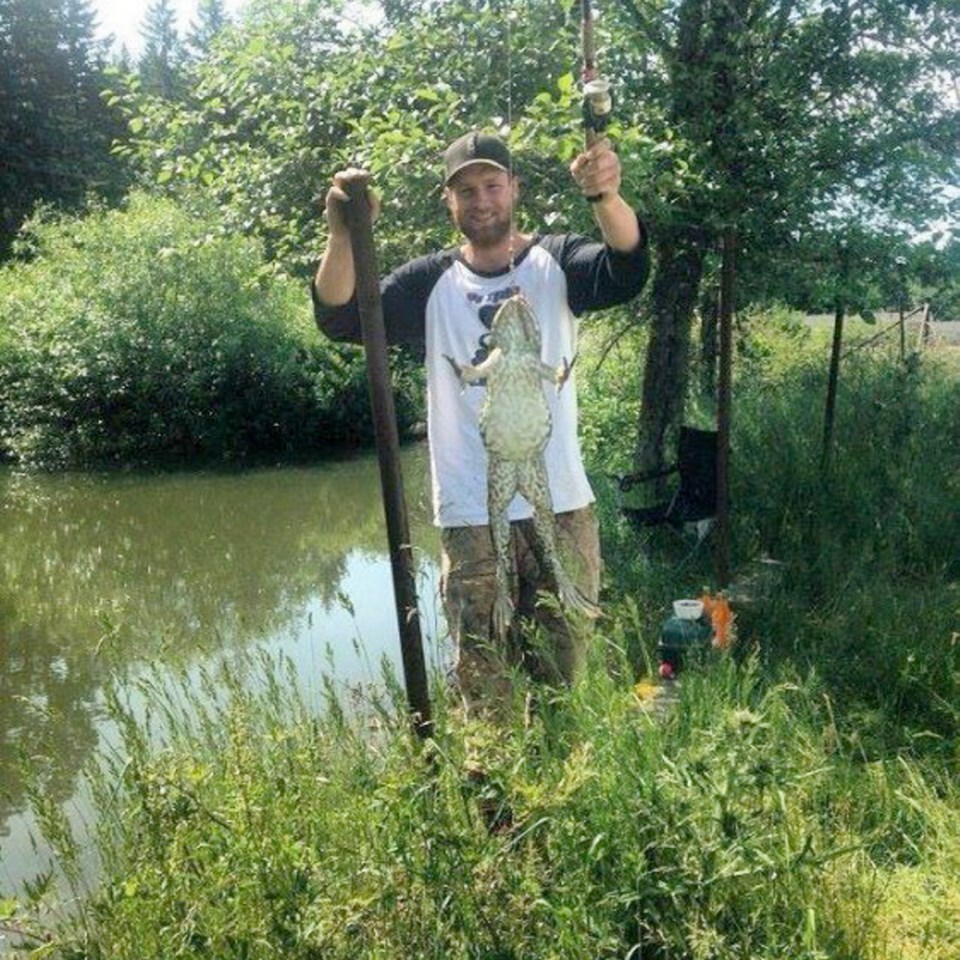A recent unexpected catch with a bobber and worm of an American bullfrog could indicate the invasive species is beginning to spread around the Alberni Valley from Sproat Lake.
On Sunday night, a photo quickly spread around Facebook of Alberni Valley resident Russ Schut, who caught the massive frog in an old dugout on his family's Beaver Creek property. "It's a pond in the middle of nowhere," said Schut's mother, Lisa Krausse.
"There isn't another water source nearby. It's an old dugout for irrigating, from 30 years ago. No water has left that pond for years. Obviously, they've come across miles of fields and bushes to get there from whatever water source."
Invasive Species Council of British Columbia executive director Gail Wallin confirmed the frog in the photo is in fact an American Bullfrog, as there is no native frog larger than the American Bullfrog.
Schut said it was approximately two feet long and weighed approximately three pounds. He chose to let it go as he did not realize at the time it was an invasive species.
"He's pretty proud that he got the big thing, he just didn't realize that they're such a bad thing that he caught," Krausse said.
The American Bullfrog species was identified as being present in Sproat Lake approximately five years ago.
According to Wallin, it is entirely possible American Bullfrogs have migrated from Sproat Lake, as they were first introduced at the south end of Vancouver Island and have since spread as far north as Campbell River.
"They're voracious eaters," Wallin said.
"They're big, and when you've got a species like that, that can basically out eat some of the native species, it will take away the forage that native species would use and at times they can be aggressive on other smallersized, earlier life-cycle size frogs. "Basically, the issue is, if they are out eating the habitat the other frogs would want to have, it displaces the native frogs."
According to the Ministry of Environment, Bullfrogs are spreading on Vancouver Island, and displacing other frogs in the habitats they invade.
The rate of the spread is currently being studied at the University of Victoria. Wallin said what should be done when the frogs are found depends on the situation. If the population is dense, "then you might just accept that you have bullfrogs."
However, if it is just a single species, contact the B.C. Conservation Officer Service for direction. In any case, Wallin said, people should refrain from emptying their aquariums into natural environments.
"Whether it's the plants in the aquarium, or the turtles, or the frog, they're probably not native and they can easily become established and take over the native population," she said.
American bullfrog
Scientific name: Lithobates catesbeiana. Status: Exotic (introduced to an area they do not naturally occur). Size: Adult female bullfrogs may reach eight inches in length (not including legs) and weigh up to 750 grams; male bullfrogs are smaller. Male bullfrogs have yellow throats while females have paler cream or white throats
SOURCE: B.C. FROGWATCH PROGRAM



